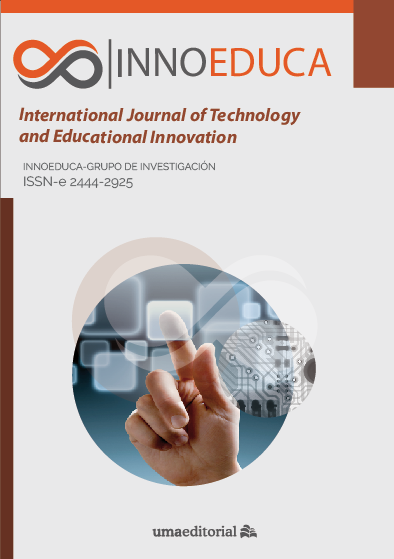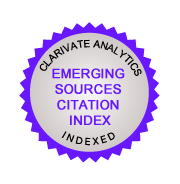Online System Argumente: a Result of Design Based Research at UNAM
DOI:
https://doi.org/10.24310/innoeduca.2022.v8i2.12300Keywords:
Educational innovation, educational research, computer system design, writing skills., Educational innovation, educational research, computer system design, writing skillsAbstract
Argumente is an online system that was created to strengthen written argumentation skills. This system was built within the framework of a research project that was carried out with students and professors of the Open and Distance Education System (SUAyED), at the National Autonomous University of Mexico (UNAM) and with the intention of implementing the Dialogue Design System written argumentation model, with distance education students. This work describes the research approach used to design, develop and evaluate the Argumente system, which it considered throughout the process both, linking it with previous results of the argumentation methodology implemented, as well as with the learning and user experience, of the different types of users. This implied the building of a broad and comprehensive work team, that worked collaboratively throughout the process. In this way, what was obtained was not only an online system to exercise written argumentation and a teaching and learning proposal that promotes the development of argumentative skills, but it also strengthened an educational research method, focused on the design of educational technology and collaborative work.
Downloads
Metrics
Publication Facts
Reviewer profiles N/A
Author statements
Indexed in
-
—
- Academic society
- N/A
- Publisher
- Universidad de Málaga
References
Brown, A. (1992). Design Experiments: Theoretical and Methodological Challenges in Creating Complex Interventions in Classroom Settings.. Journal of the Learning Sciences, 2(2), 141-178.
De Benito, B., & Salinas, J.M. (2016). La investigación basada en diseño en Tecnología Educativa. RIITE. Revista Interuniversitaria de Investigación en Tecnología Educativa, 0, 44-59. http://dx.doi.org/10.6018/riite/2016/260631
Enríquez, L., Brás, I., & Hernández, M. (2020). Diseño de diálogo en línea como estrategia para la argumentación. En M. E. Chan y L. R. Mateos (Coords.), Horizonte educativo: una mirada al futuro de las profesiones y la educación (pp.253-276). Universidad de Guadalajara.
Goff, W. M., & Getenet, S. (2017). Design based research in doctoral studies: Adding a new dimension to doctoral research. International Journal of Doctoral Studies, 12, 107-121. https://doi.org/10.28945/3761
Hallström, J. (2020). Embodying the past, designing the future: technological determinism reconsidered in technology education. International Journal of Technology and Design Education, 32, 17-31. https://doi.org/10.1007/s10798-020-09600-2
Makino, Y., & Leppisaari, I. (2014). Dialogue Design System in a Mass Lecture Class: Bridging the Cultural Gaps in Pedagogy through Operation Videos. In Proceedings of World Conference on Educational Media and Technology 2014, (pp. 1361-1370). Association for the Advancement of Computing in Education (AACE).
Oliver, M. M. (2011). Technological Determinism in Educational Technology Research: Some Alternative Ways of Thinking about the Relationship between Learning and Technology. Journal Of Computer Assisted Learning, 27(5), 373-384. https://doi.org/10.1111/j.1365-2729.2011.00406.x
Reeves, T.C. (2006). Design research from a technology perspective. In J. van den Akker, K. Gravemeijer, S. McKenney & N. Nieveen (Eds.), Educational design research (pp. 52-66). Routledge.
Serdyukov, P. (2017). Innovation in education: what works, what doesn´t, and what to do about it? Journal of Research in Innovative Teaching & Learning, 10(1), 4-33. https://doi.org/10.1108/JRIT-10-2016-0007
Vesin, B., Mangaroska, K., & Giannakos, M. (2018). Learning in smart environments: user-centered design and analytics of an adaptive learning system. Smart Learn. Environments. 5, e24. https://doi.org/10.1186/s40561-018-0071-0
Downloads
Published
How to Cite
Issue
Section
License
All contents published by Innoeduca. International Journal of Technology and Educational Innovation are subject to Creative Commons Attribution-Nocomercial-NoDerivatives 4.0 International License, whose complete text can be consulted at https://creativecommons.org/licenses/by-nc-nd/4.0/legalcode. Thus, copying, distribution, public communication, derivative works and commercial use of content are permitted as of the aforementioned issue provided that the source and the author of the text are cited.
It is the responsibility of the authors to obtain the necessary permits for images that are subject to copyright.

This work is licensed under a Creative Commons Attribution-NonCommercial-NoDerivatives 4.0 International License.













242.png)








